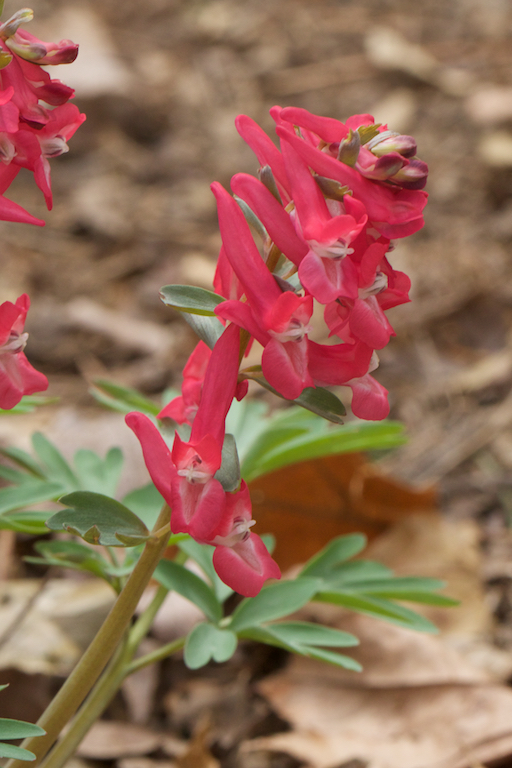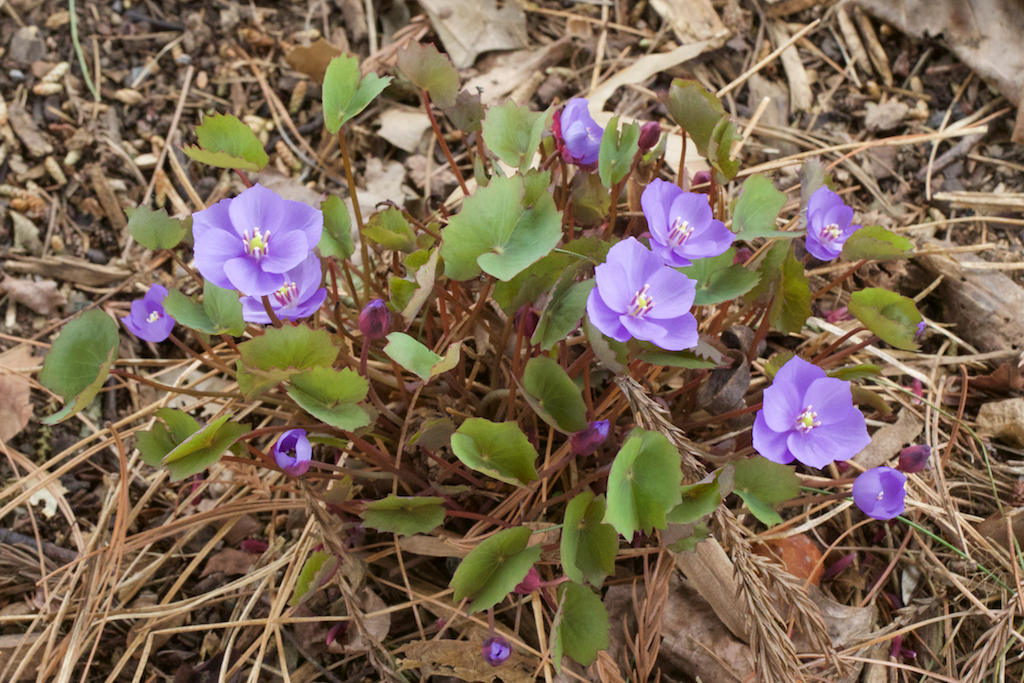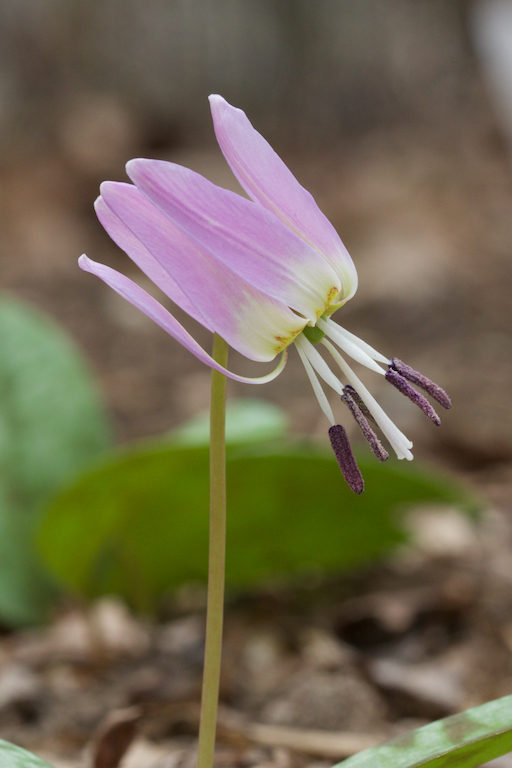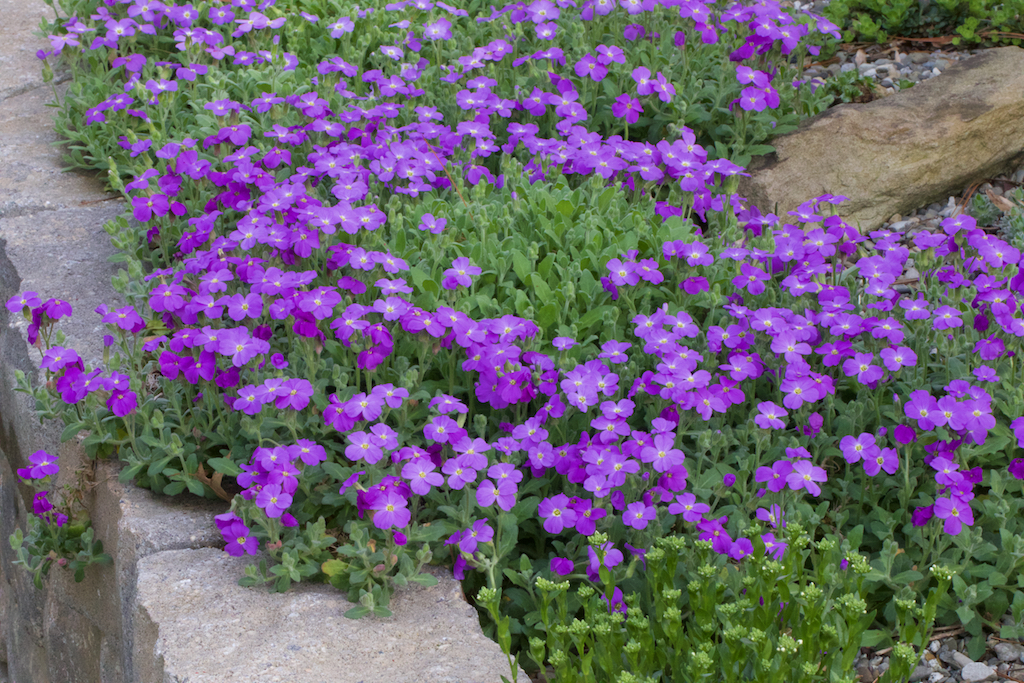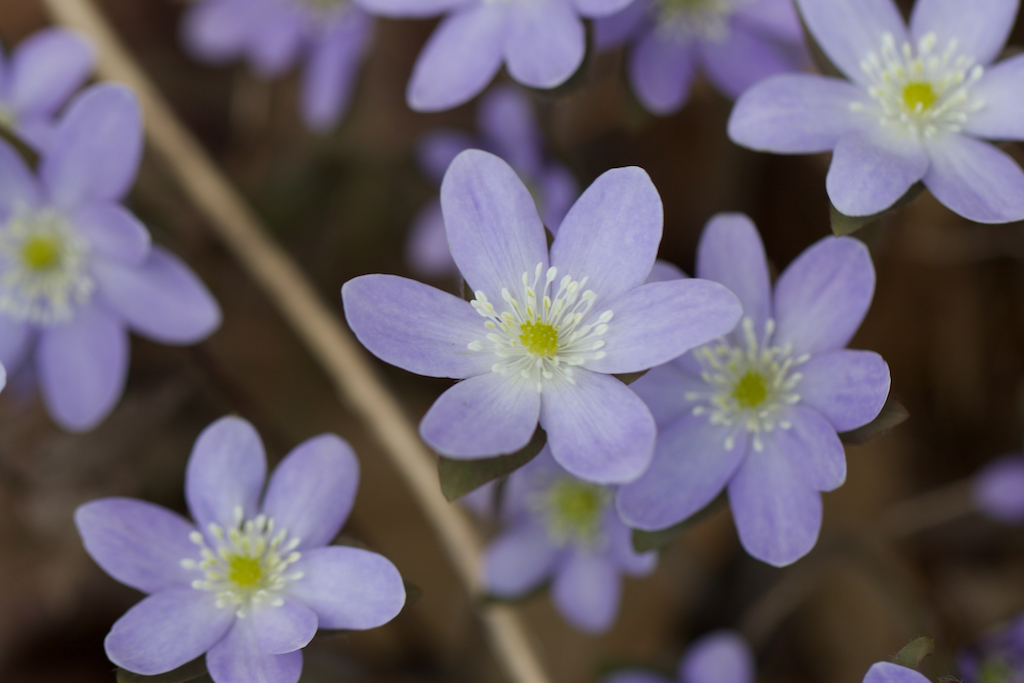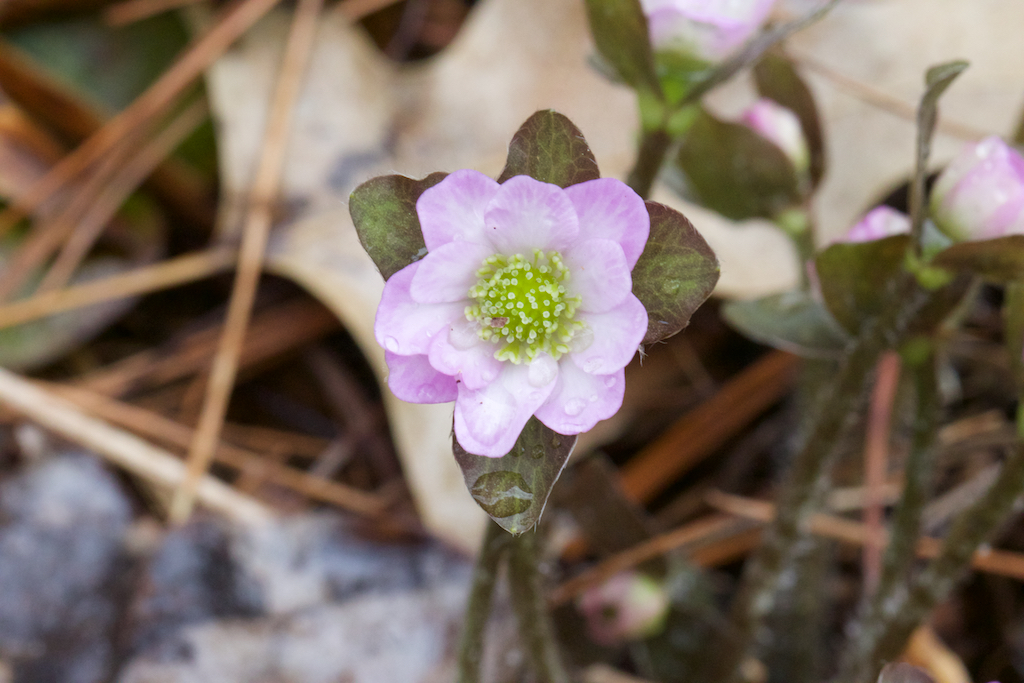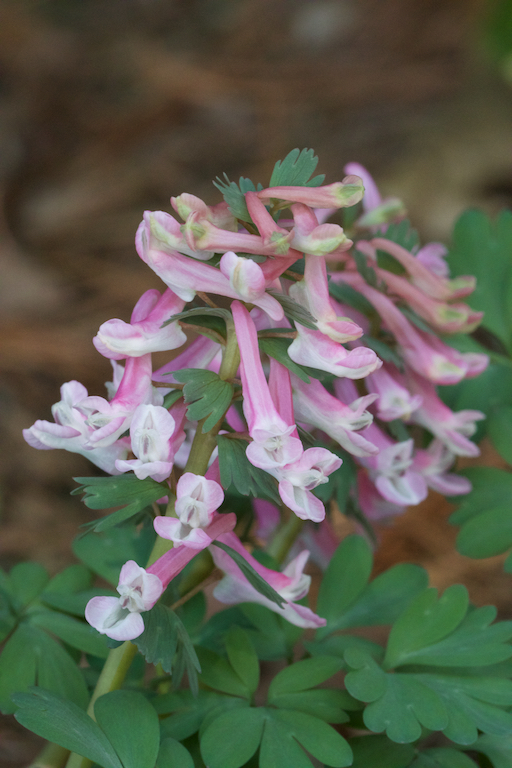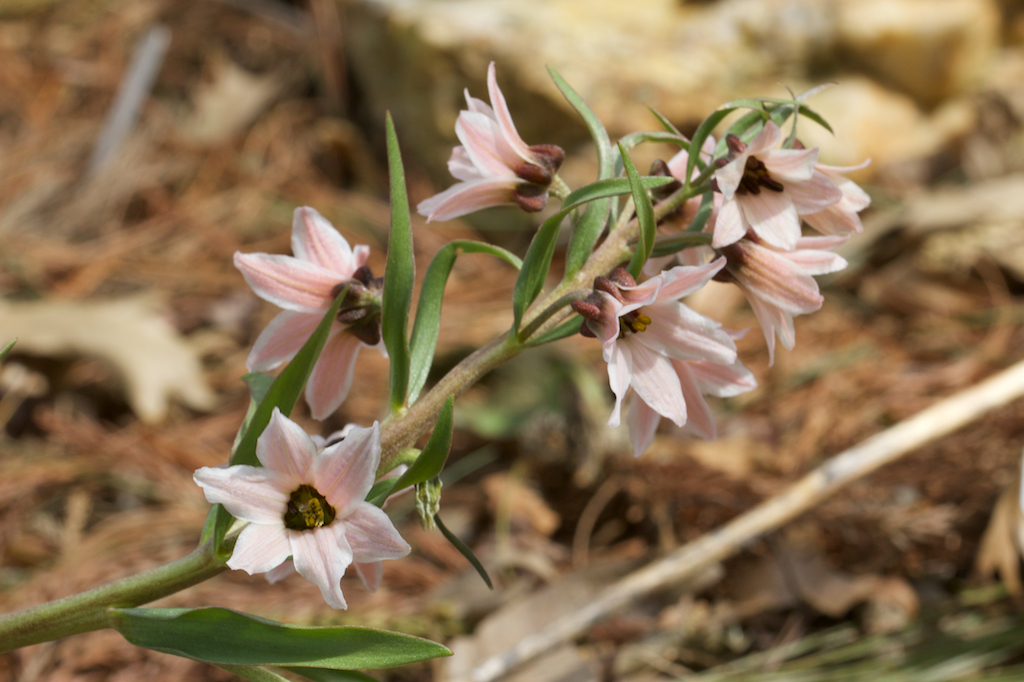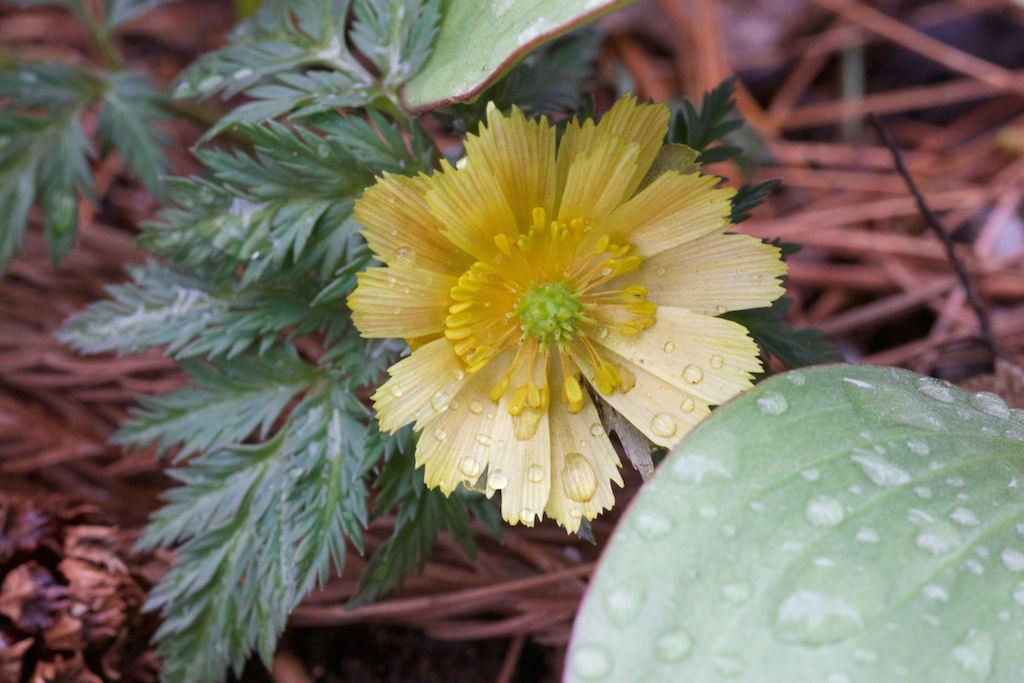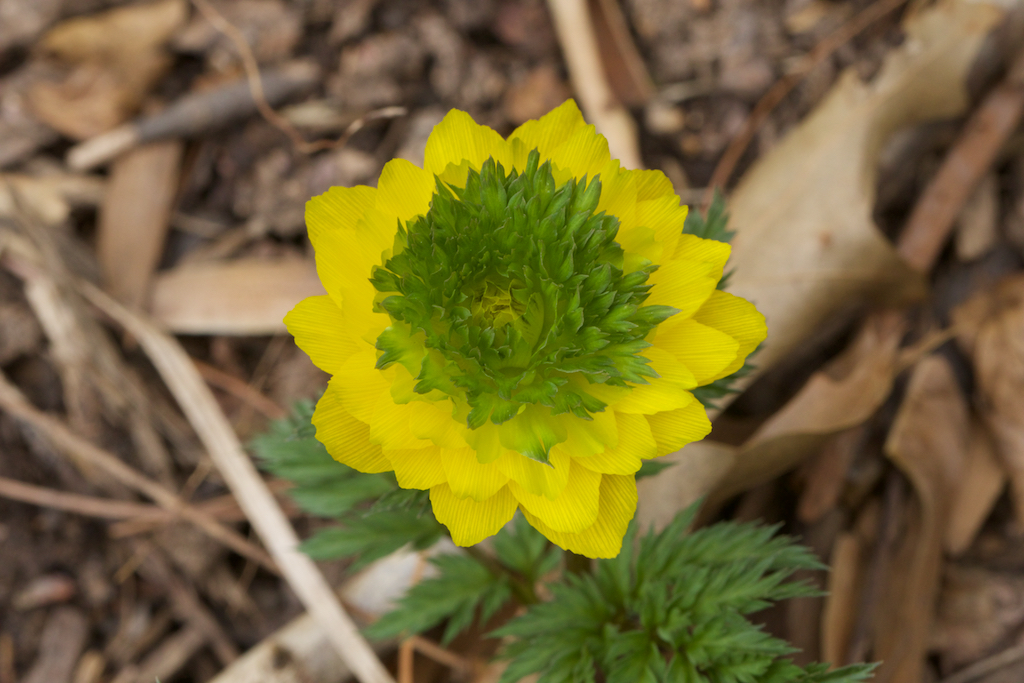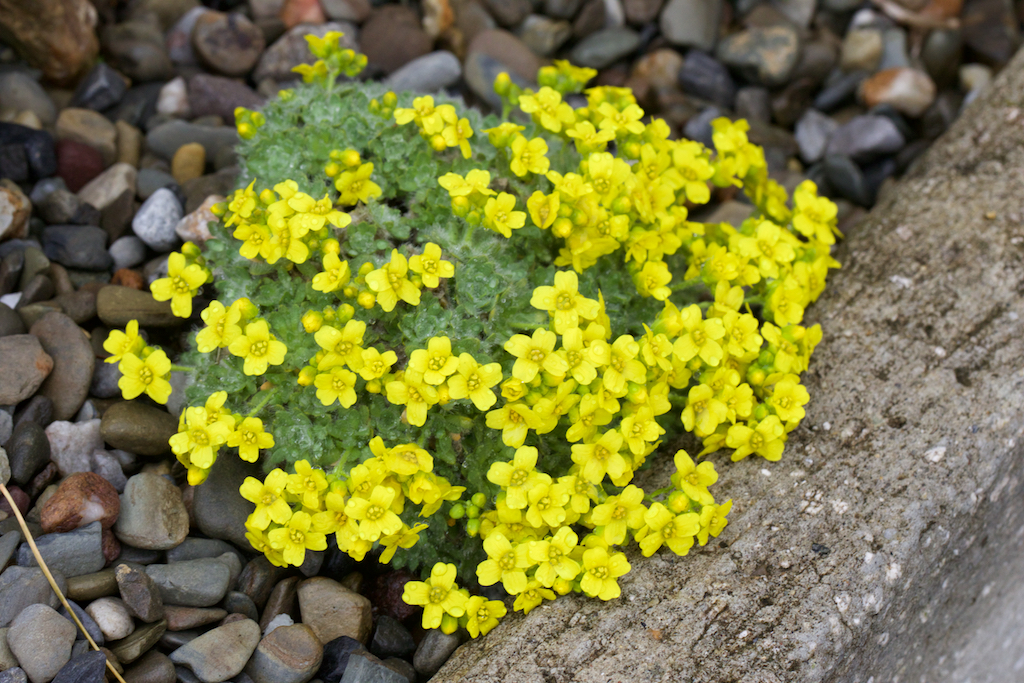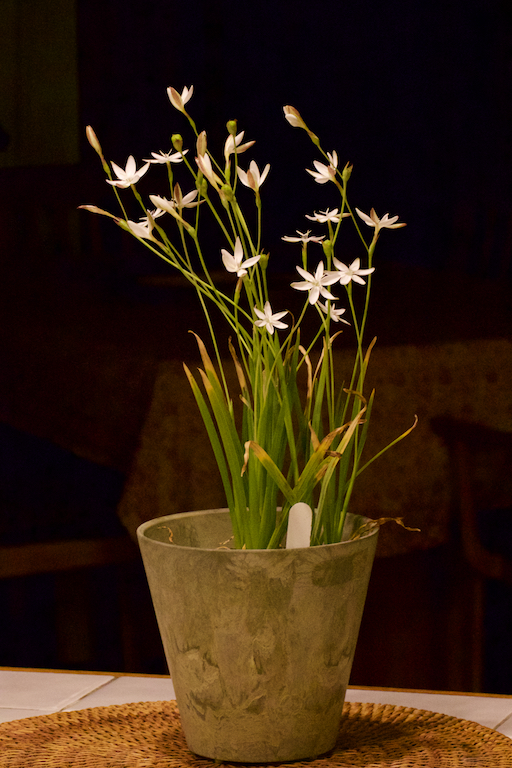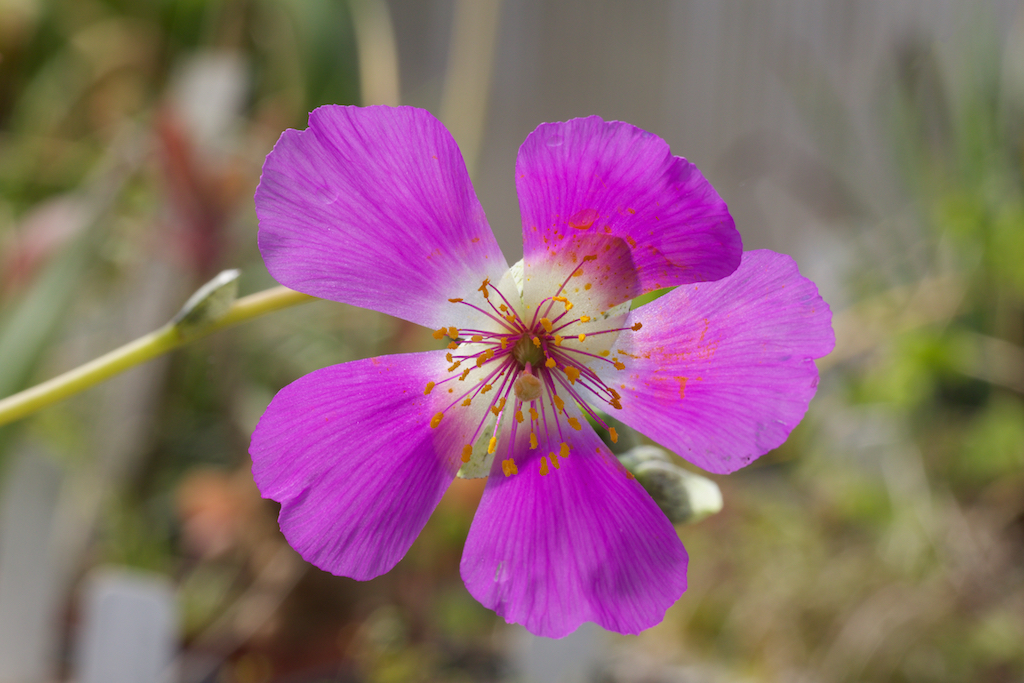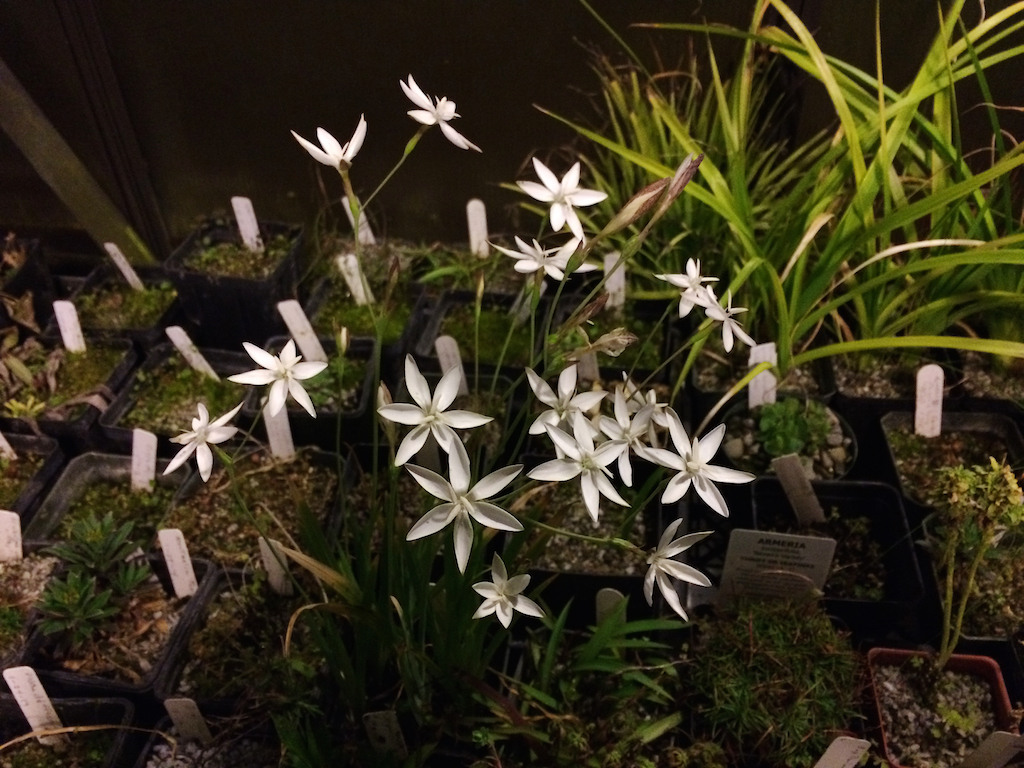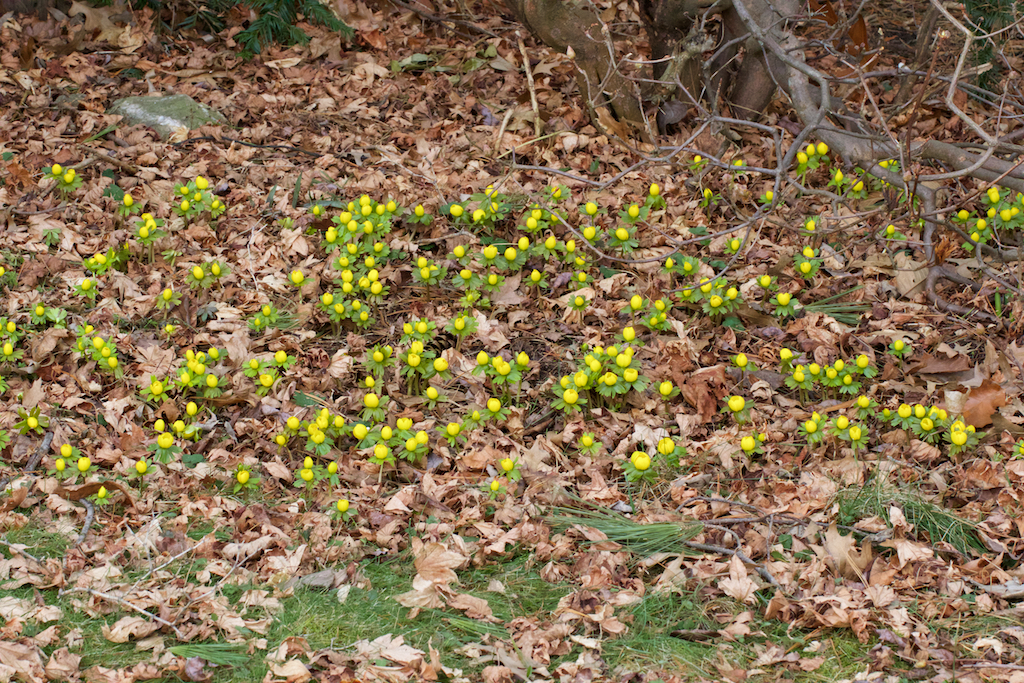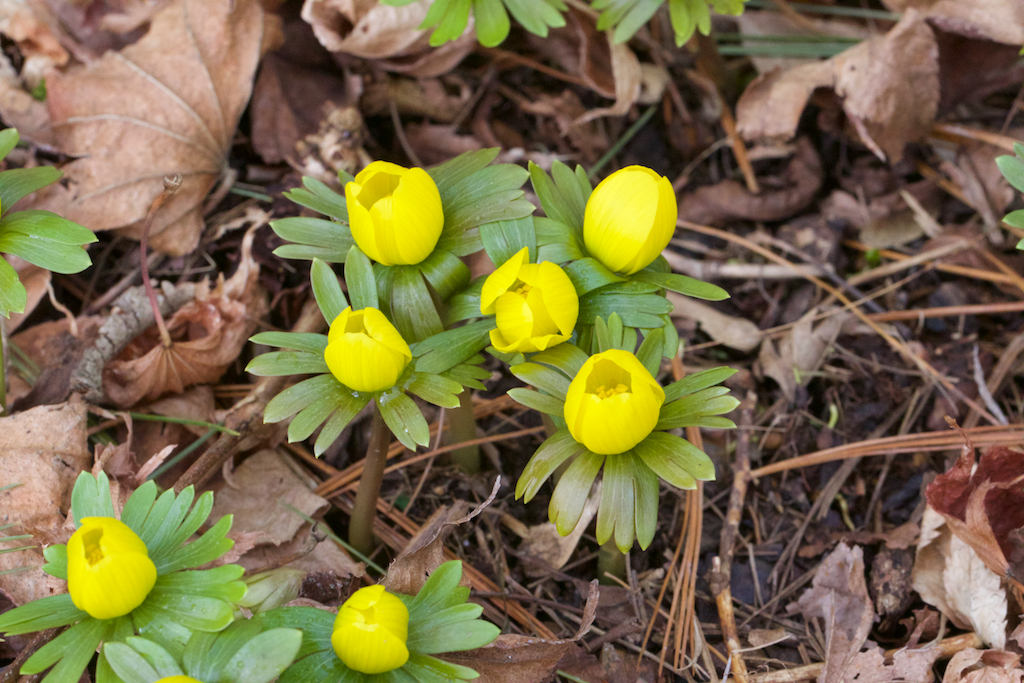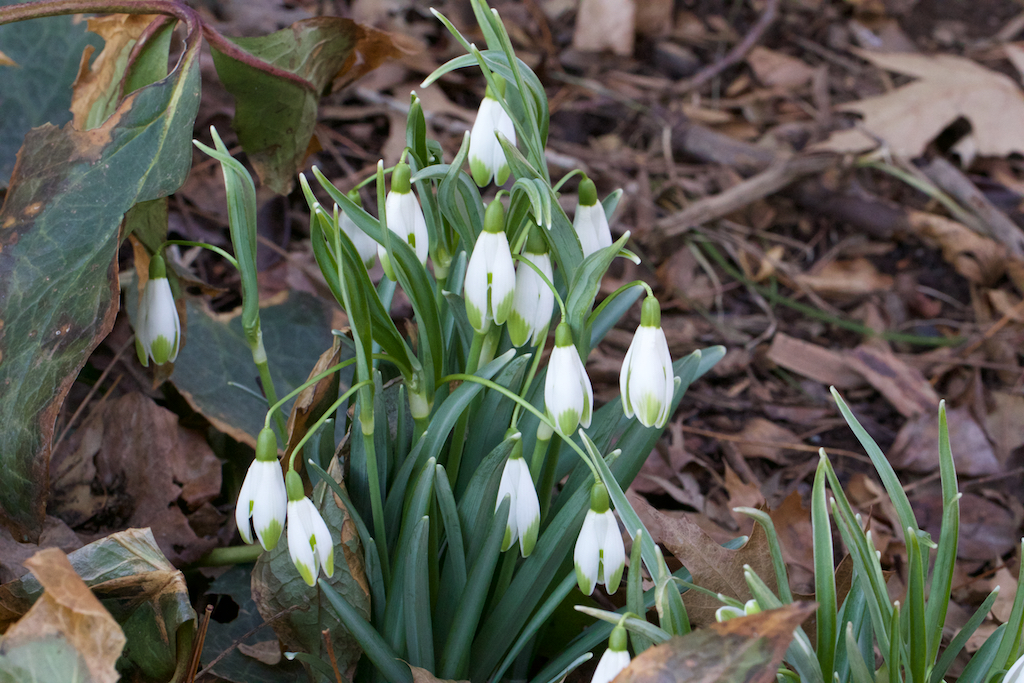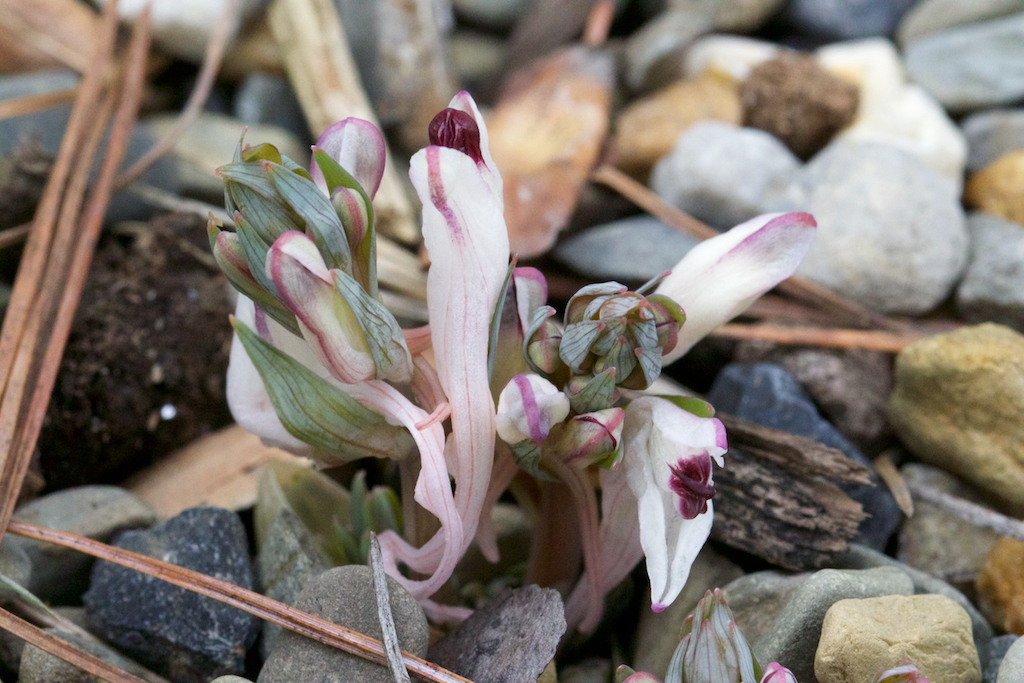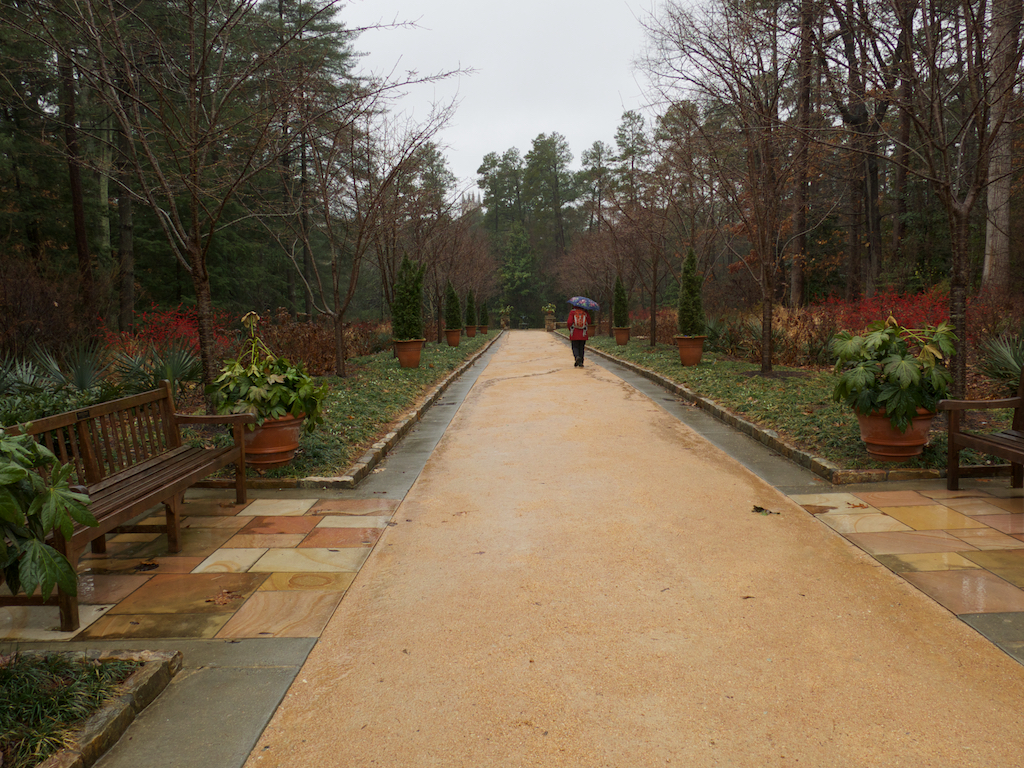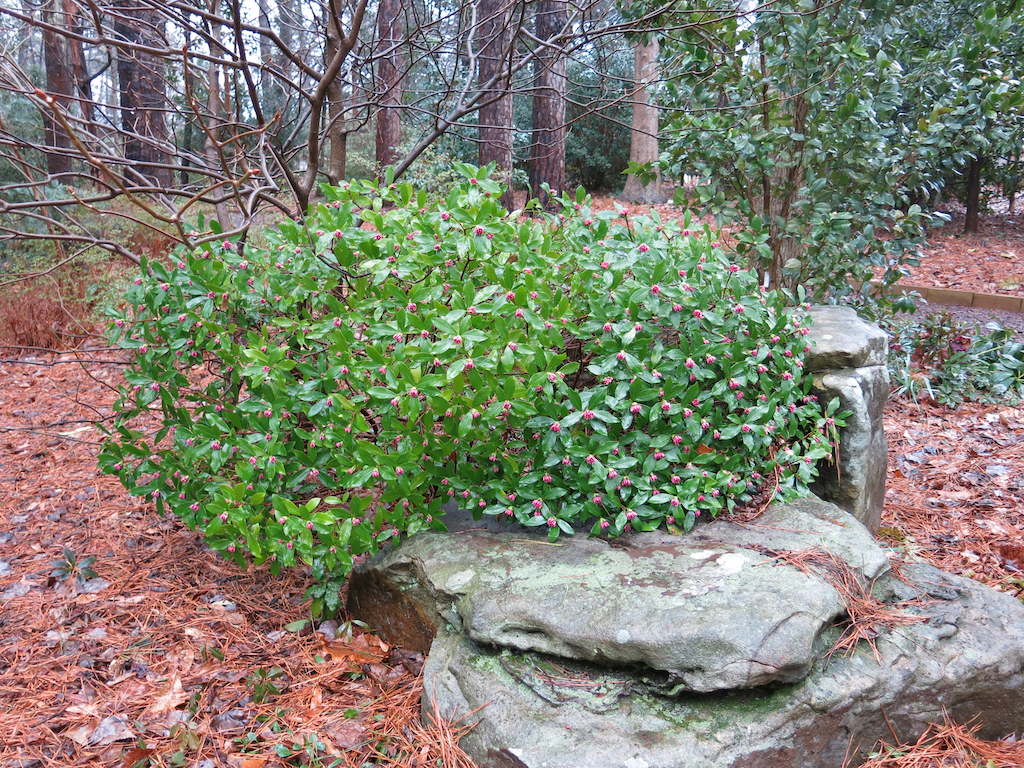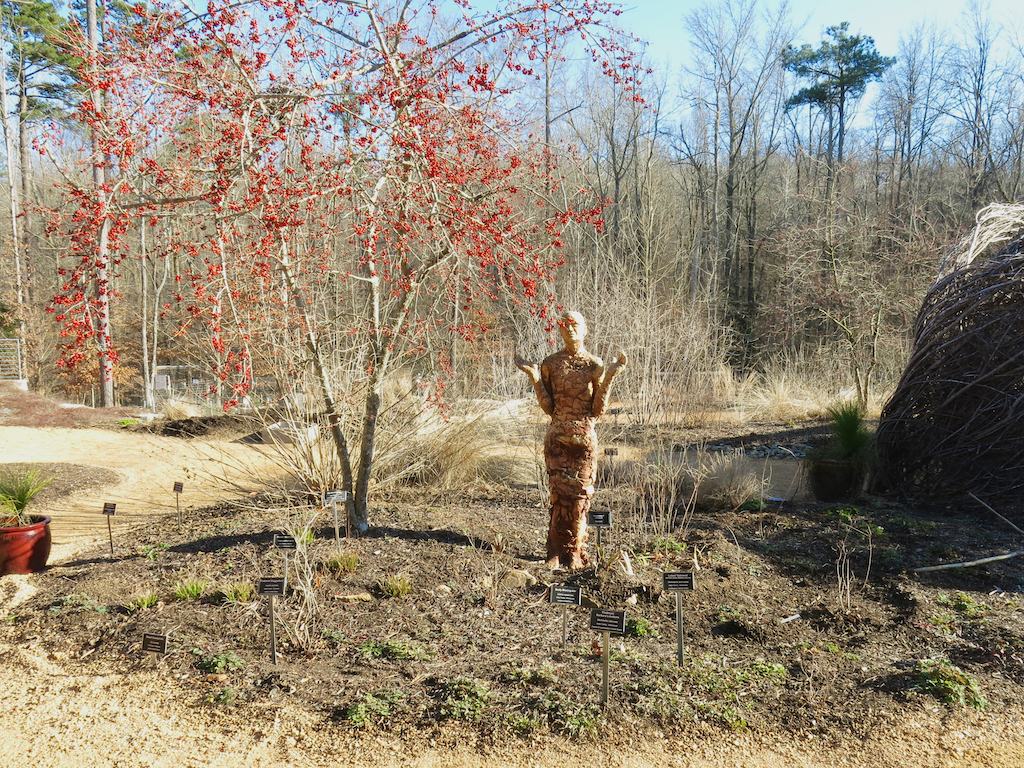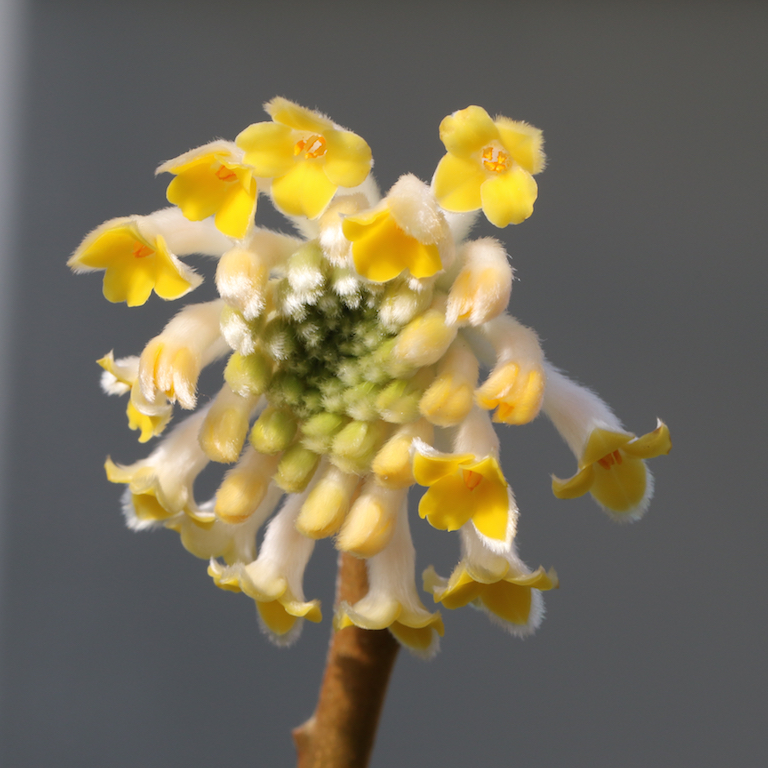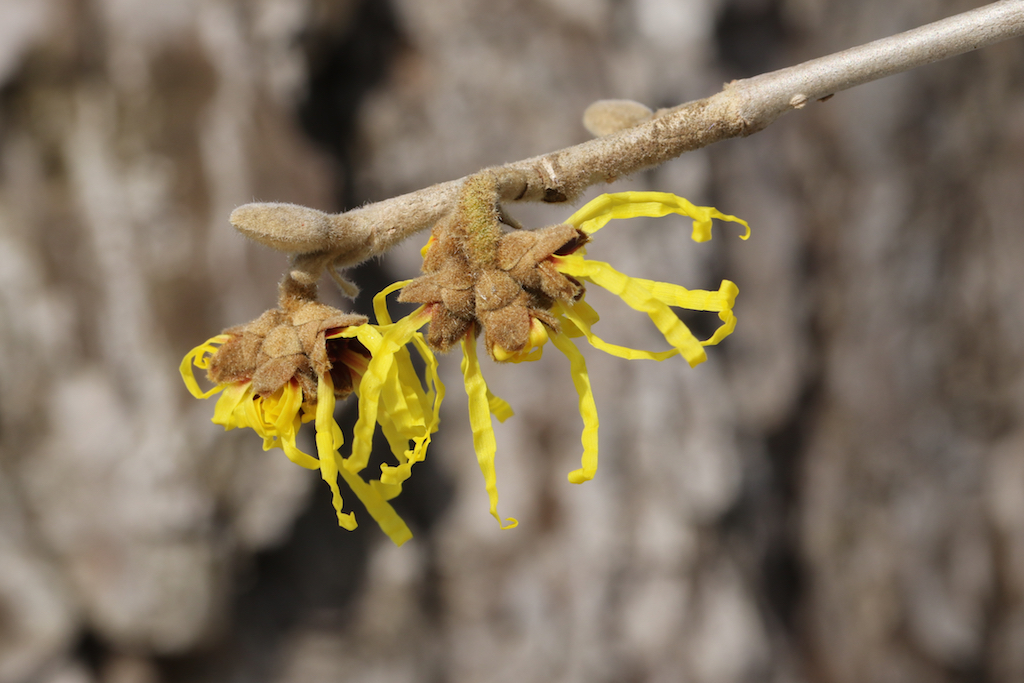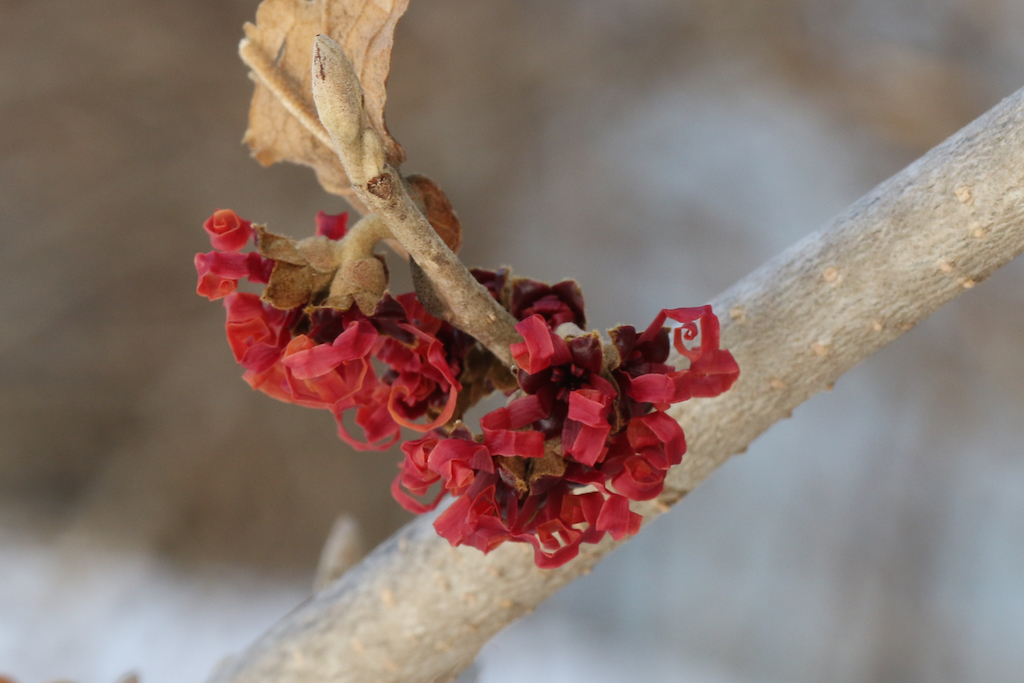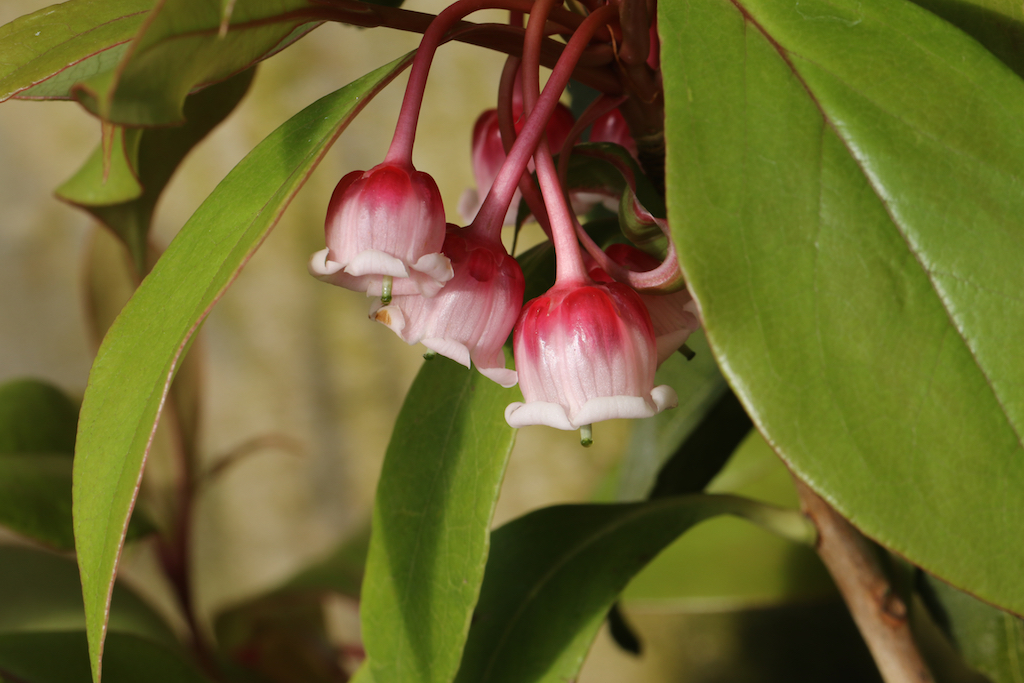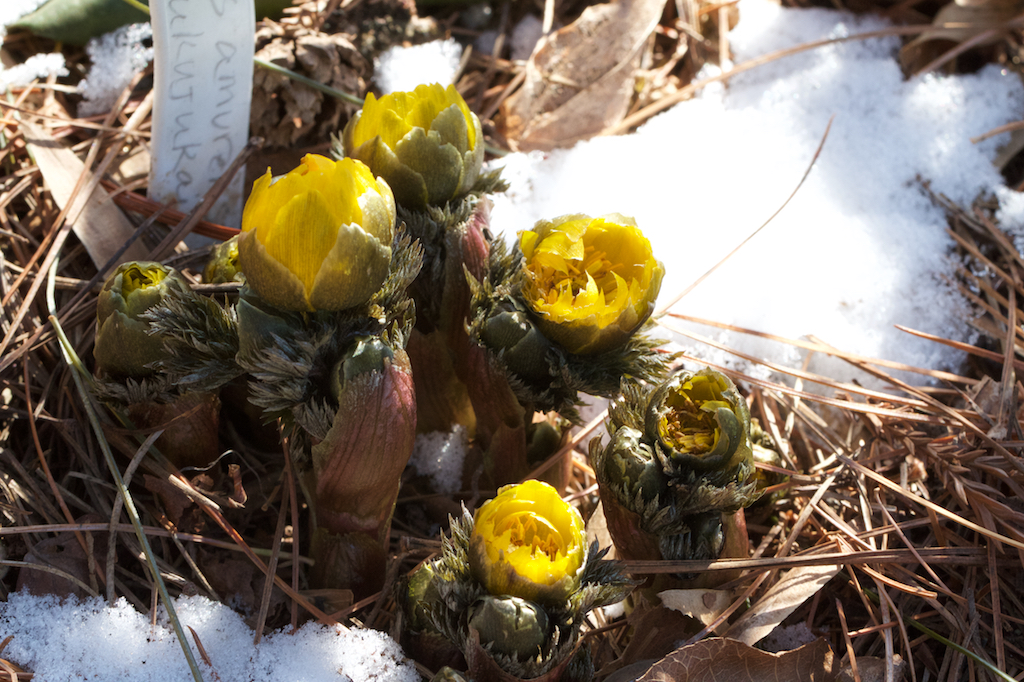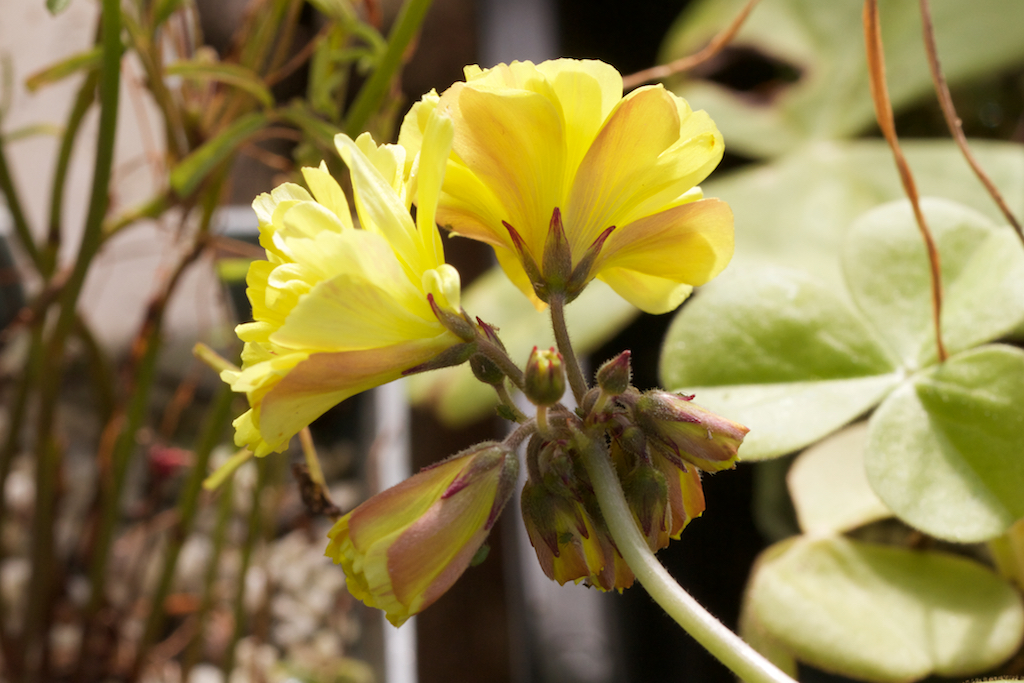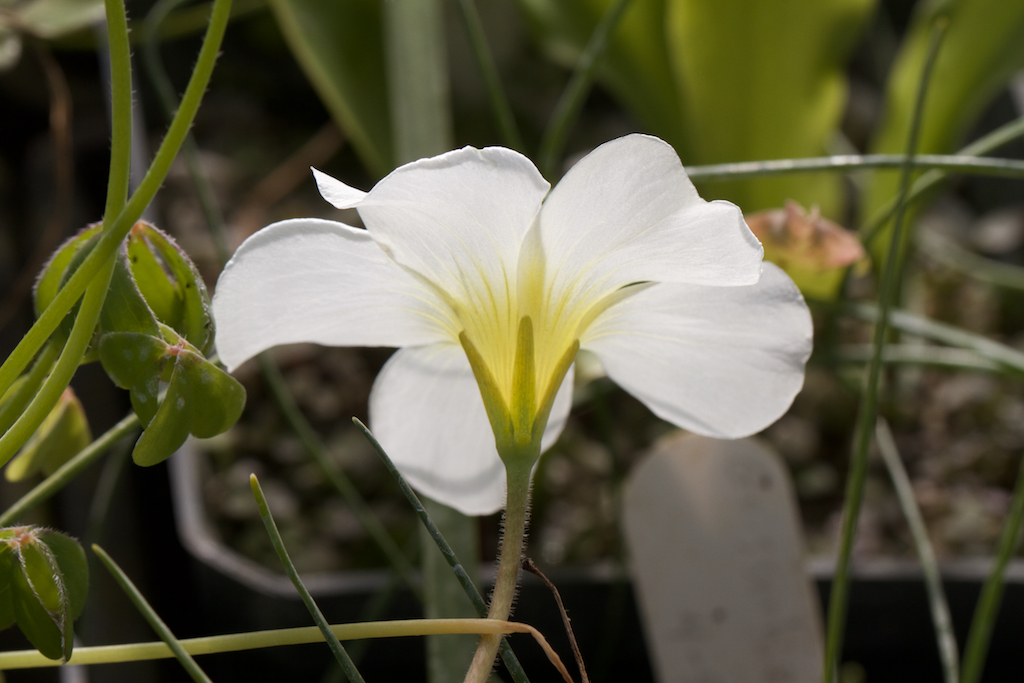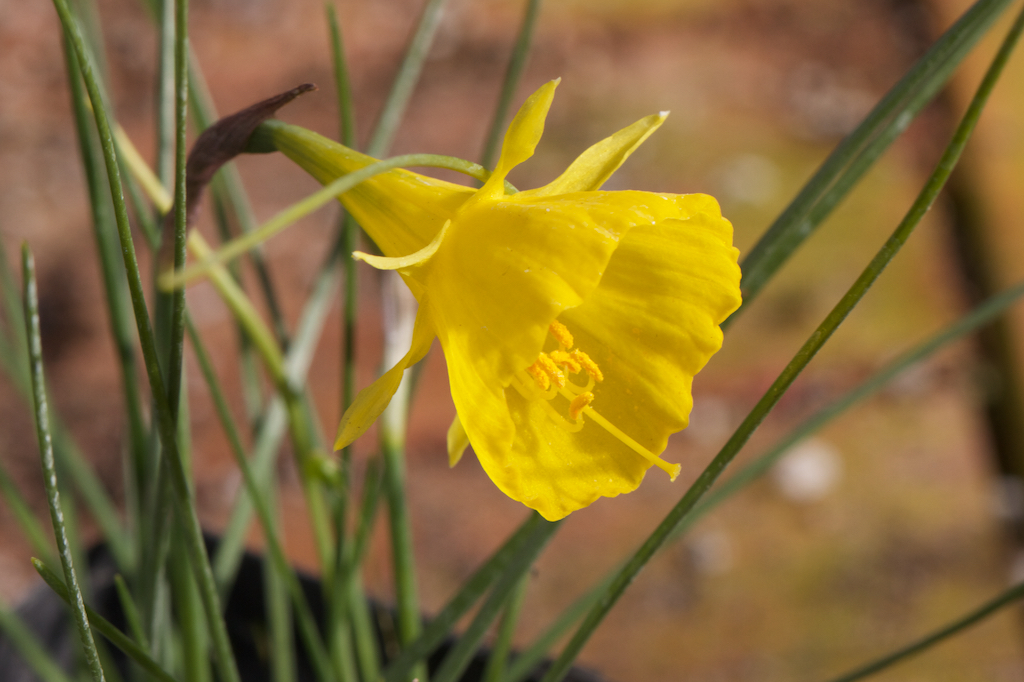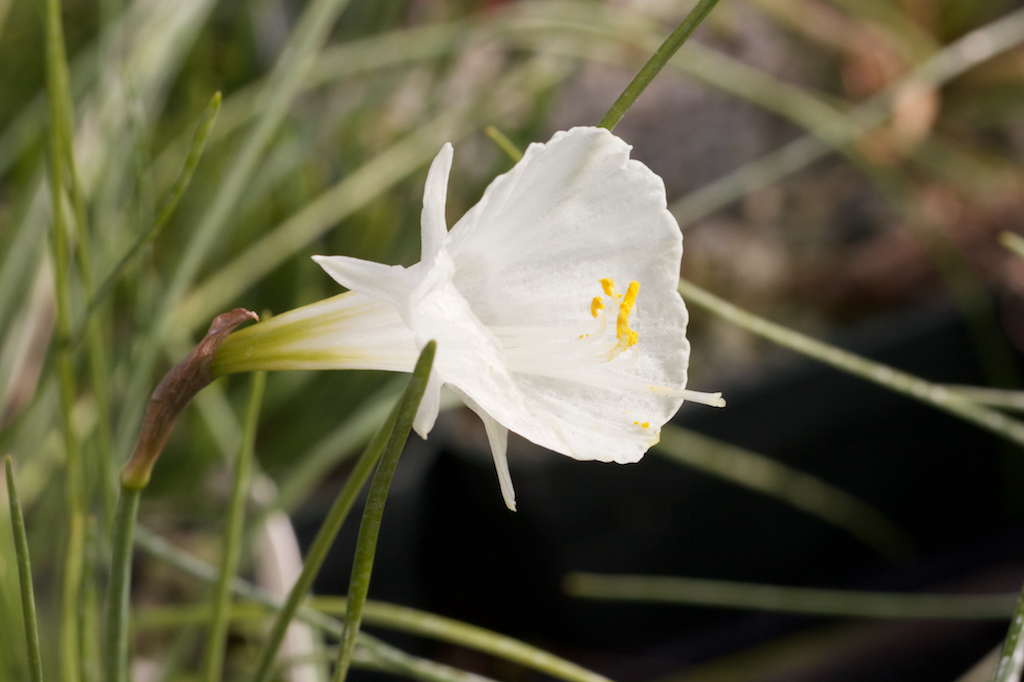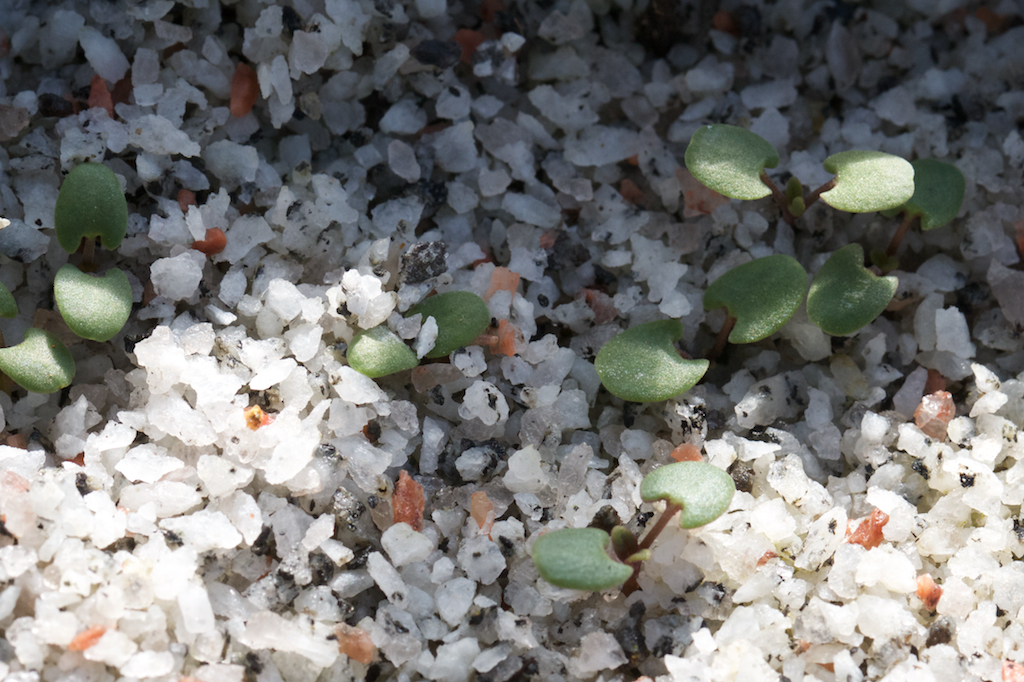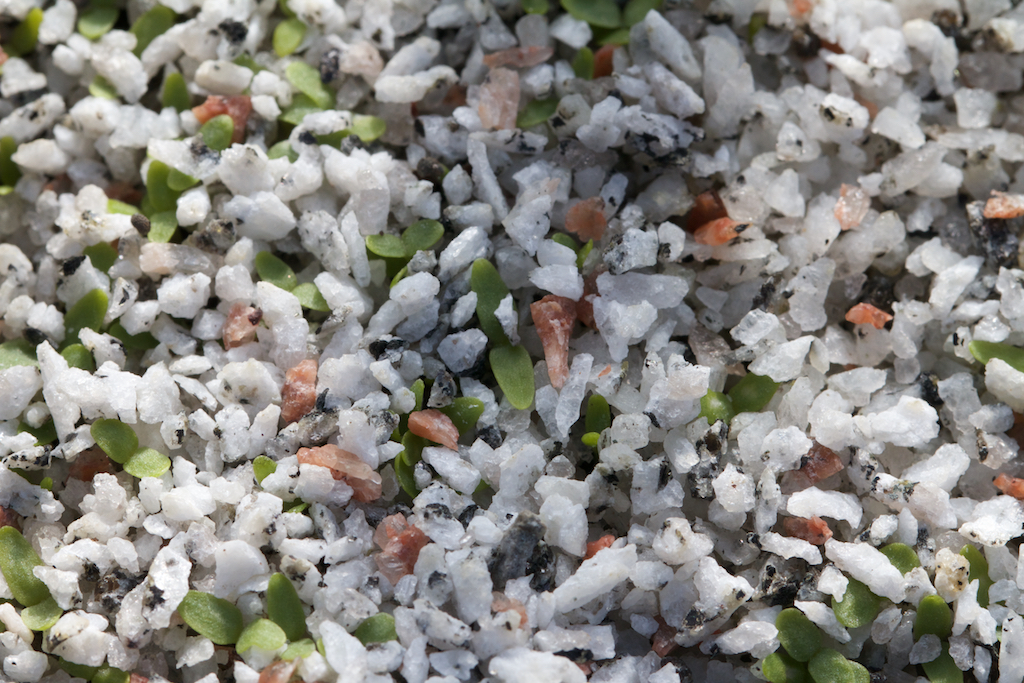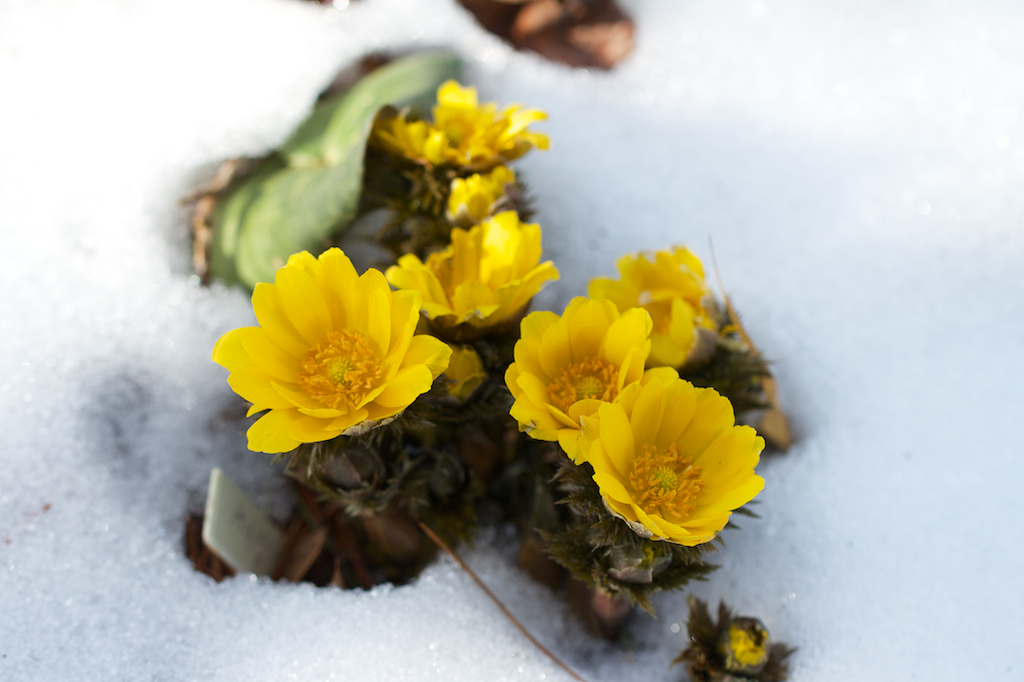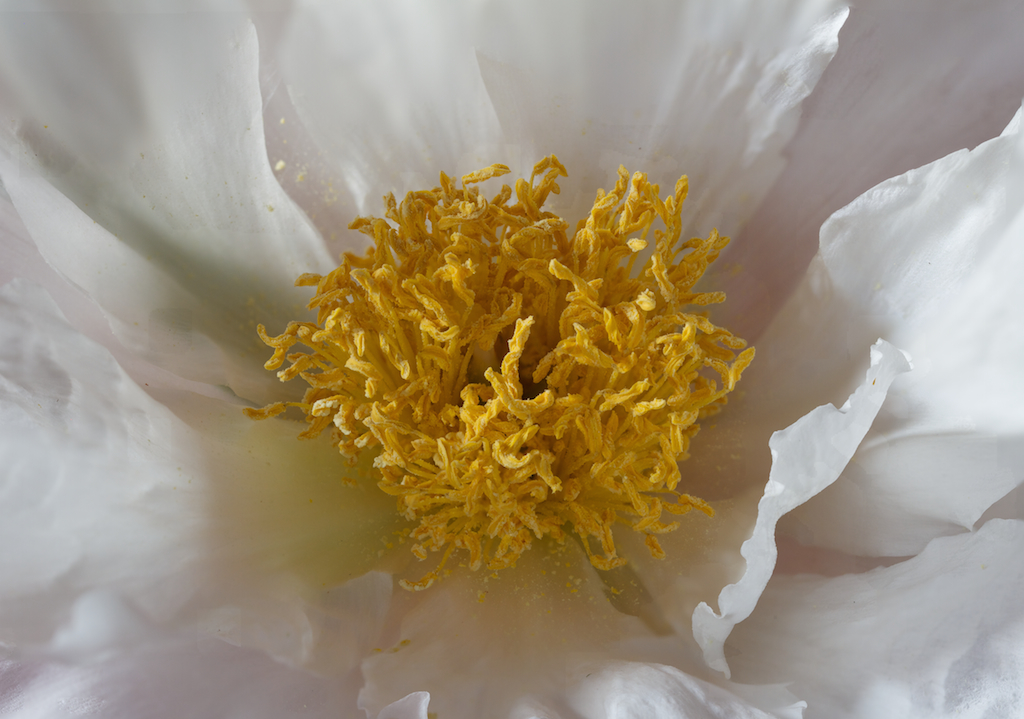As I was gathering up pictures for this post, I found it hard to stay focussed on the task. Each image I came across seemed to lead me down a path of ‘what was the name of that flower?’. I clearly need a garden elf who goes around checking on labels. Anyway, let me begin by saying April is, as always, a time of flower abundance so that Garden Blogger’s Bloom Day is necessarily a picking and choosing of which flowers to display. The daffodils are everywhere and their fragrance dominates the inside of the house and all of the gardens. But it is also a time to revel in the Hellebores who, though they started much earlier, have not gone away at all.
In contrast, it is worth noting that this is the peak time for the spring ephemerals which clamor to be appreciated for their very short time on the stage. They are generally around for just a few days at most and require getting down on your hands and knees to see the wonderful details.
A longer lasting springtime favorite is the Roadrunner trillium.
In the orchard and the woods the cherries are in bloom.
And alpine bed and troughs feature some distinctive flowers that are not usually part of the Maryland landscape.
Inside the house, the clivia is trying hard to make us focus on indoor flowers.
And lastly, since I am well past the normal posting time, let me close with the latest Cypripedium that we added from this year’s visit to Plant Delights. It’s a ahead of it’s season because I’ve just taken it from the greenhouse.
Happy Easter
Beth and son Josh dyed Easter eggs yesterday to continue a tradition going back many years. No little kids around this weekend but we can pretend.
The first week of April is a great time for the spring ephemerals. It seems like everything wants to come out the ground at once following the winter doldrums. I am especially fond of hepaticas and they are in the midst of their bloom cycle right now.
This is a particularly large flowered hepatica that I got several years ago from Seneca Hill Perennials (now closed).
Also in flower is a lovely pink seedling from Hillside Nursery.
A few years ago I got a pink seedling from Thimble Farms that has lovely purple stamens. It’s very hard to photograph because the slightest breeze will set it to vibrating.
I’ve also noticed that one of the american hepaticas has a very nice pink cast to it.
There are more hepaticas still emerging. Meanwhile their friends the corydalis are popping up around the yard.
One of Janis Ruksan’s best corydalis is Gunite, named after his wife.
A rather special flower is the Fritillaria stenanthera.
It is unlike any other Fritillaria that we have.
The flowers point outward and are individually quite lovely. It seems to be thriving outside.
Right beside it is a very nice adonis. This was apparently a spot that I thought was exceptional because I put two rather nice plants in about the same place. We will let them work it out.
Of course my go-to Adonis for distinctive variety is always Adonis ‘Sandansaki’.
In it’s early stage it has only a small green bud in the midst of a yellow flower. By the end, it’s pretty much all green lion’s mane.
It has three buds this year, the most ever.
Other yellow highlights are in the troughs and the alpine beds.
This one sits in the small trough by the back door.
The Draba acaulis is in one of the large troughs by the door to the greenhouse. Nearby is a pasque flower getting ready to emerge.
Reliably scattered around the yard are Primula vulgaris to reflect the way they are found in the wild in England.
And of course I’ve not mentioned the daffodils all over the place or the Hellebores that are everywhere — but that’s another story…
Back to the Greenhouse
The greenhouse has been celebrating the oncoming springtime with a celebration all its own. All those South African plants that don’t really make it on the outside in Maryland are just having fine time in the greenhouse. Everyone that opens up is another surprise when I go out to the greenhouse.
Speaking of surprises I need to resolve the nocturnal dilemma that I mentioned in my last posting. I had asked for an ID for the lovely white flowers that surprised me by opening only at night. As it turns out I got two helpful replies that pointed toward Hesperantha cucullata. I followed up by looking at the NARGS seed distribution for 2013 where I had gotten the mislabeled seed and found that there was Hesperantha falcata in the distribution. I looked at the characteristics of the flower and I think this is the most probable identification. However, Mary Sue Ittner notes that H. cucullata is frequently mislabeled as H. falcata. At her suggestion I took the flowers into the house where we could observe the after dark behavior. It turns out that they gradually opened as the night progressed, being fully open after about 9pm, with a gradually increasing jasmine-like fragrance that peaked about 2am. It’s a wonderful plant.
I’ve just returned from a week-long trip to Florida to photograph birds and many of the outside springtime flowers are beginning to come out. But just to finish the greenhouse theme, let me share some of the other greenhouse flowerings that have occurred.
And then to close with two of the Ferrarias.
A Nocturnal Puzzle
I was surprised when I went out to the greenhouse last night to discover there was a flowering party going on and I had not been invited. I went out there just to look any random slugs that might be taking the opportunity for an evening stroll. These little star shaped flowers blew me away, because in the daytime they look like this.
The label says Babiana odorata which they definitely are not. However, I’m not sure just what they are. The foliage looks gladiolia-like, the buds and flower stalks look kind of like Ornithogalum, but the flower doesn’t resemble anything that I can identify.
These plants came from seeds distributed by NARGS in 2013. It’s possible they actually flowered last year, but I wouldn’t have known unless I went out to the greenhouse after dark. The flowers seem to persist, not the once and done like some of the South Africans. I’m hoping someone in the Pacific Bulb Society can help me out on this one. The night blooming should be a dead giveaway.
It’s a busy time for the greenhouse with seed starting, sheltering the new arrivals, and seeing some of the South African plants flower for the first time.
A couple of other South Africans popped out today.
Meanwhile on the outside the sunshine brought the crocus into full bloom.
It’s a wonderful time of year!
Garden Blogger’s Bloom Day March 2015 — Hello Chichibu Beni !
It’s Garden Blogger’s Bloom Day and what better way to welcome in the spring than seeing our first orange adonis for the year. The plain vanilla yellow adonis are seldom seen but this diminutive beauty is even rarer. This has been such a long cold winter that the flowers are grateful to finally see a little sunshine warming things up. The Adonis are always among the first plants to call for attention in the springtime. The yellow ones are also up and waiting to smile at the sunshine.
Notice all the flower buds in this clump.
Out in the front yard the winter aconite have finally popped and show the evidence of the many years they have been colonizing the front bed.
I think this was originally ten small tubers.
Of course snowdrops are everywhere right now. The Viridapice are particularly nice.
The surprise entry for the day was the first of the corydalis. These have popped up in the alpine bed.
Other than these there are some crocus, the witch hazels, and a lot of wannabe flowers. I think are right on the verge of seeing many more flowers.
In the greenhouse there are a few special items worth highlighting. For the first time we have Tulbaghia from a 2013 bulb planting.
There is a very nice small ornithogalum species that derives from Jane McGary by way of Pacific Bulb Society distribution.
And a freesia with many flowering stalks.
The Lachenalia mutabilis is nice enough that we brought it into the house.
That’s it for March 15th. What’s growing in your garden?
A Spectacular Carolina Weekend
We just spent a marvelous weekend in Raleigh, North Carolina in an escape from the last snowstorm (I hope) to hit Maryland this year. We had planned this weekend for a visit to the North Carolina nurseries but when a significant snowstorm threatened for last Thursday, we decided to skip town on Wednesday and I’m glad we did. It gave us an extra day to visit nurseries and gardens in the ‘Triangle’ area. Even four days is not sufficient to see all that this area offers to plant lovers. There are three major gardens in Raleigh, Durham, and Chapel Hill and we went to each.
Sarah P. Duke Gardens at Duke University in Durham is what I would characterize as a display garden. It’s well funded and beautiful and has lots of examples of how to make a dramatic landscape.
It had many lovely individual plants including this daphne which illustrated how daphnes want to look in the wintertime as opposed to the burned leaves on ours.
The North Carolina Botanical Garden in Chapel Hill also appears to have a lot of financial backing and it’s focus seems to be well-coupled to the University’s effort to encourage the use of native plants.
It’s set next to woodland trails and seems to get a lot of visitors for that reason.
But our favorite was the JC Raulston Arboretum in Raleigh. This is a plantsman’s paradise. Many examples of exotic and unusual plants from all over the world including this dwarf Dawn Redwood.
It was still a little early in the season for any of these gardens but the Ralston captured our hearts.
One of the ulterior motives for this particular weekend was to attend an An Evening with the Plant Explorers at the JC Ralston. This was a wonderful event with 4 1/2 hours of tales of plant exploring mixed in with socializing and plant auctions. Anyone who thinks Latin is a dead language needs to attend one of these events. The plant auction was particularly interesting because it was often for plants that had been part of the explorers’ talks.
In particular we were taken by a marvelous Einkianthus, the likes of which we had never encountered.
Well, in the end this was our take-home plant from the auction…
The other main component of the weekend was visiting nurseries. First and foremost was Plant Delights (which has a bonus of a very nice garden as well). As usual we found many wonderful plants that jumped into our car.
There were three crates like this one that we brought home including many new hellebores.
And then we went out to Pine Knot Farms where the focus is hellebores.
And we came away with even more hellebores as well as multiple cyclamen from John Lonsdale and a Mahonia confuse ‘Narihira’ (which we had seen at Raulson) and Edgeworthia chrysantha from Superior Plants.
John Lonsdale says that Edgeworthia survives for him in Pennsylvania so I have high hopes for it in Maryland.
Lastly we stopped at Camellia Forest and picked up four new camellias and two exquisite miniature Rhododendrons.
Altogether a wonderful weekend, and by the time we arrived back home the spring was waiting for us…
Let me close with one more shot of that Einkianthus which I hope will be with us for a long time…
Garden Blogger’s Bloom Day
It’s Garden Blogger’s Bloom Day and there could be few days that would seem to be less promising for flowers. The temperature topped out at 19º today and is headed for 3º tonight. There was no real full-throated flowering outside in Maryland today, at least not on our hillside. I did manage a few spots of interest as I took a short, well-wrapped walk around the yard. It’s not surprising that the Adonis is fully ready to flower if we ever get a break from this weather.
Despite the picture we don’t have much more than a smattering of snow. Mostly it’s just cold. I guess the good part for the plants is that it hasn’t been the same cycle of warm then cold that we had last year. Any plant with good sense is staying well curled up right now. The first snowdrops were out a few weeks ago and they were knocked down by wind and the tiny bit of snow we had last night.
The other hint of spring that I saw outside was the first coloring up of the red witch hazel.
Every little bit of color gets bonus points right now.
Most of the flowering that I have to offer is in the greenhouse. The greenhouse got down to 31º last night with all the heating I normally use. And that was on a 9º night. So I’ve added another temporary heater to the 110v circuit in hopes that I can cope with the 3º in the forecast. There are a lot of plants out there worth protecting. We have enjoyed a lot of oxalis. Some even go through a second flowering.
The oxalis are particularly interesting from side and back views as well.
Since December we’ve been enjoying a sequence of hoop Narcissus as well.
These frost-tender narcissus all come from Spain or North Africa and I don’t find they have the distinctive fragrance that I associate with Narcissus. Nonetheless they are easy to grow from seed and make nice companions to the oxalis to brighten up a winter day.
One of the things that leads me out to the greenhouse every day is checking on the new seedlings from the seed exchange plantings. I never fail to be amazed at the rapid development of the plants that come in those little tiny seeds.
These plants are all tickets to adventure. Researching these plants often leads me to reading the history of the species or the journals of the expeditions the plant explorers still take in the search for new plants. Google the names of the seedlings above and see what you discover…
There was another sign of spring in the greenhouse today. I saw the first growth on the pomegranate. After last year I am looking forward to harvesting our own pomegranates again.
Picture This – Best of 2014
Many garden bloggers will recall that Gardening Gone Wild used to run a regular photo contest where people shared there images from the garden. It was fun activity which encouraged one to take on certain challenges in photographing the garden. Well, Saxon Holt, at Gardening Gone Wild has restarted the Picture This activity. As a first challenge he has asked that we post our favorite photos from 2014 and select one for submission to the Picture This photography contest. This actually struck a chord with something that I had been meaning to do anyway in response to the annual suggestion from Les at A Tidewater Gardener. I post so many pictures in a year that it is somewhat of a task to go back through the years images and choose the best, but that being said here goes…
The picture of the Greenhouse is not so much a picture of high technical quality but one which captures a moment that sets forth the whole year. We had a difficult winter that ended up making every flower that survived that much more of a special gift. The other pictures are mainly of flowers that track the progress of the year.
February
It was the first year I grew ferrarias. They are spectacular in every respect.
Nearby and almost at the same time as the ferraias was a delicate oxalis that was especially charming seen from the side and rear.
March
The adonis are so wonderful at combatting the snow, even as early as they come into flower.
April
You have to kneel down to see those blue stamens, but wow are they ever spectacular.
This is a Sierra Nevada endemic that is one of the parents of the commercially successful ‘Pagoda’ erythronium. It has an almost ethereal purity.
May
Speaking of purity, it is hard to exceed the golden stamens on white petals featured on this peony.
June
Sometimes the profile of a flower is more effective than the full on in your face shot. I wish that this were actually my rose, when in fact I took the shot while touring Maryland gardens in June with the Four Seasons Garden Club.
Then there are the flowers that are not strictly flowers that stick in your memory. This is my favorite arisaema.
Finding the British Soldier Lichen on our garden fence post was one of the treats of the year. Not only are they useful, but they are exceedingly beautiful if you look closely.
July
I think it was about 10pm when I photographed this Epiphyllum in bloom. It was busy extending an invitation to the local bats.
August
What I especially like about this picture is the way the colors overlap between the fly and flower…
September
There are so many of these perfectly formed anemones in September that you wonder that more people don’t given them space in the garden.
One of the constraints of the Picture This photo contest is that I now have to select one of the above for my entry. I like so many of these, but if I have to choose one it will be the Peony ‘Krinkled White’ as it appeared in June.








